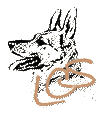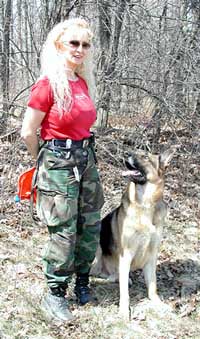Canine Good Citizen (CGC)
The purpose of the Canine Good Citizen program is to ensure that our favorite companion, is a respected member of the community because it is trained to act mannerly in the home, in public places, and in the presence of other dogs. The CGC Test is AKC administered and is non competitive. All dogs who pass all 10 items of the test receive a certificate.The Canine Good Citizen Test is a certification program that tests dogs in simulated everyday situation in a relaxed atmosphere. It identifies and rewards dogs that have the training and demeanor to be reliable family member as well as community members in good standing. Dogs are not required to perform items on the test with the precision required in formal obedience. Handlers are encouraged to communicate with their dogs throughout the test. However, harsh corrections are grounds for dismissal.All test are performed on leash. Dogs should wear well-fitting buckle or slip collars of fabric, leather or chain. Pinch collars and head halters are NOT permitted. Leash should be either leather or fabric. The long lead required in the tests will be provided by the testers.There is no age limit for the CGC test. However proof is required of vaccinations, including rabies. Proof of licensing, where applicable, is also required. Indications of aggression, including growling, snapping, biting or attempts to attack to either another dog or person will not be tolerated or if the dog eliminates during the test will not pass and be dismissed from the test.
The Test
1 Accepting a Friendly Stranger
This test demonstrates that the dog will allow a friendly stranger to approach it and speak to the handler in a natural, everyday situation.
The evaluator walks up to the dog and handler and greets the handler in a friendly manner, ignoring the dog. The evaluator and handler shake hands and exchange conversation. The dog must not show signs of shyness or resentment.
2 Sitting Politely for Petting
This test demonstrates that the dog will allow a friendly stranger to touch it while it is out with its handler. With the dog sitting at the handler's side to begin the exercise, the evaluator pets the dog on the head and body only. The handler may talk to the dog. The dog must not show shyness or resentment
3 Appearance and Grooming
This practical test demonstrates that the dog will welcome being groomed, and examined and will permit someone, such as a veterinarian, groomer or friend of the owner, to do so. It also demonstrates the owner's care, concern and sense of responsibility.
The evaluator inspects the dog to determine if it is clean and groomed. The dog must appear to in healthy condition. The handler should supply the comb or bush. The evaluator then softly combs or brushes the dog and, in a natural manner, lightly examines the ears and gently picks up each front paw.
The dog must not show signs of shyness or resentment.
4 Out for a Walk (Loose Lead)
This test demonstrates that the handler is in control of the dog. The dog may be on either side of the handler, whichever the handler prefers. The dog's position should leave no doubt that the dog is attentive to the handler and is responding to the handler's movements and changes of direction. The dog need not be perfectly aligned with the handler and need not sit when the handler stops.
The evaluator may use a pre-plotted course or may direct the handler/dog team by issuing instructions or commands In either case, there must be a left, right and about turn, with at least on stop in between and another at the end. The handler may talk to the dog with praise for a job well done.
5 Walking Through a Crowd
This test demonstrates that he dog can move about politely in pedestrian traffic and is under control in public places.
The dog and handler walk around and pass close to several people (at least three). The dog may show some interest in the strangers but should continue to walk with the handler, without evidence of over-exuberance, shyness or resentment. The handler may talk to the dog and encourage or praise the dog throughout the test
6 Sit and Down on Command/Stay in Place
This test demonstrates that the dog has training, will respond to the handler's commands to sit and down and remain in the place commanded by the handler.
Prior to the test the dog's leash is replaced with a 20-foot line. The handler may take a reasonable amount of time and use more then one command to make the dog sit and then down. The evaluator must determine if the dog has responded to the handler's command. The handler may NOT use force in to either position.
When instructed by the evaluator, the handler tells the dog to stay and walks forward the length of the line, turn and return to the dog at a natural pace. The dog must remain in the place in which it was left.
7 Coming when Called
This demonstrates that the dog will come when called by the handler. The handler will walk 10 feet from the dog, turn and face the dog, and call the dog. The handler may use encouragement to get the dog to come. Handlers may choose to use stay or wait as a command or they may just simply walk away.
8 Reaction to Another Dog
This demonstrates that the dog can behave politely around other dogs.
Two handlers and their dogs approach each other from a distance of about 10 yards, stop, shake hands and exchange pleasantries, and continue on for about 5 yards.
The dogs should show no more than a casual interest in each other. Neither dog should go to the other dog or its handler.
9 Reaction to Distractions
This test demonstrates that the dog is confident at all times when faced with common distraction.
The evaluator will select only two of the following
a. A person in a wheelchair or walker
b. A sudden closing or opening of a door
c. Dropping a large book, no closer than 10 feet behind the dog
d. A jogger running in front of the dog
e. A person on a bike
f. A chair falling not closer than 6 feet away
The dog may express a natural interest and/or appear slightly startled but should not panic, try to run away, show aggressiveness or bark. The handler may praise or encourage throughout the exercise.
10 Supervised Separation
This test demonstrates that a dog can be left with a trusted person, if necessary, and will maintain its training and good manners. Evaluators are encouraged to say something like "Would you like me to watch your dog?" and then take hold of the dog's leash. The owner will go out of sight for three minutes. The dog does not have to stay in position but should not continually bark, whine, or pace unnecessarily, or show anything stronger than mild agitation or nervousness



